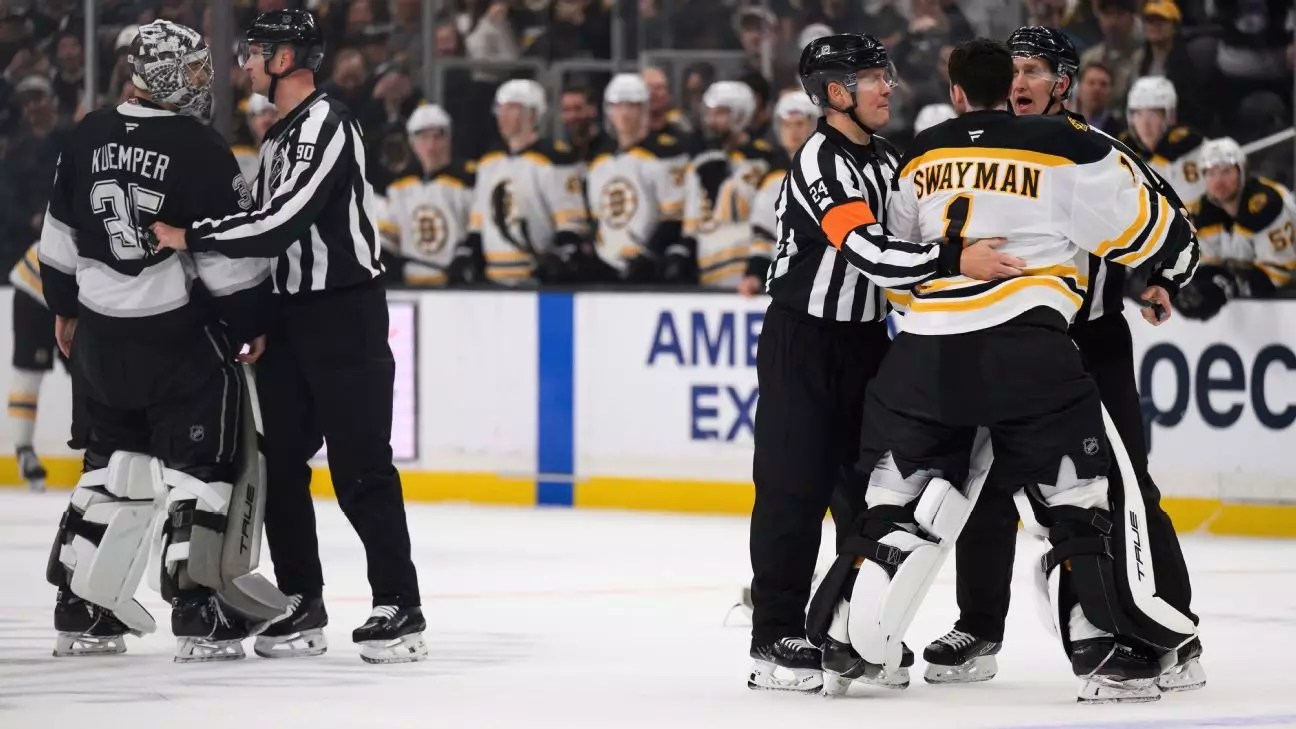A palpable tension filled the air at the Staples Center on Sunday night, transcending the typical excitement of a thrilling hockey game. As the Los Angeles Kings faced off against the Boston Bruins, the scenario shifted dramatically late in the second period. Darcy Kuemper, the Kings’ goalie, and Jeremy Swayman from the Bruins seemed on the verge of an all-out goalie brawl, a spectacle that has been scarce in the NHL since the onset of the pandemic. Head coach Jim Hiller for the Kings was undoubtedly experiencing a whirlwind of emotions. The thought of his star goalie in a potential fistfight conjured images of injuries, suspensions, and the chaotic aftermath of such an event.
Both coaches recognized the significant risks associated with allowing their goalies to throw down. After all, these players are not just protectors of the net; they are critical to their respective teams’ chances of success. Hiller’s thoughts likely spanned from the existential dread of losing a key player to the sheer tomfoolery of what a fight would entail. Fortunately, the officials swiftly intervened, steering both players away from a potentially destructive clash, preserving their talents for the remainder of a match that was already leaning heavily in favor of the Kings.
Designated Descent into Chaos
The near altercation stemmed from a chaotic moment when Bruins forward Marat Khusnutdinov made contact with Kuemper, courtesy of a back-checking hit by Kings player Tanner Jeannot. This collision initiated a flurry of penalties, including goaltender interference, while an emotional Kuemper retaliated by grabbing Khusnutdinov in a dramatic display. The situation escalated as Swayman cast aside his demeanor and emerged from his crease, ready to defend his teammate’s honor, echoing a sense of camaraderie that often underpins team sports.
Swayman’s candid remarks about Kuemper’s actions highlighted the unwritten code among players—defend your mates at all costs. While the decision to challenge Kuemper could have led to devastating consequences, it spoke volumes about Swayman’s passion and commitment to his team. Much to the relief of both coaching staffs, the tightly wound situation defused before any physical confrontation could materialize. Despite receiving penalties for leaving their creases, the strong, vocal actions of both goalkeepers reflect the ferocity and spirit within the game.
The Unwritten Rule of Goalie Fights
Interestingly, the pattern of physical confrontations among goalies has shifted dramatically since the COVID-19 pandemic. With the last recorded fight between goalies occurring in 2020, the NHL has seen a considerable decrease in such instances, indicating a transitioning culture. Fans, in their fervor for action, often express disappointment when a scheduled showdown is called off. They thrive on the energy that comes from such spectacles—albeit the negative repercussions involved for both teams.
Hiller’s concerns are justified; injuries can derail entire seasons. Consider the Kings—the current home record champions with an impressive 25-3-4 status. Kuemper’s recent refrain from a loss at home for over 14 games showcases his importance to maintaining that record. A small dive into statistics hints that injuries incurred during a senseless goalie brawl may have dire consequences. The dramatic essence of the fight can be enticing and generate excitement, yet it often comes at an exorbitant cost.
Referee Interventions: The Guardians of the Rink
The officials played a crucial role in this precarious moment by quickly stepping in and separating the two poised combatants. Referee Graham Skilliter and linesman Travis Toomey’s quick actions proved paramount in preserving the integrity of the match, reaffirming their duties extend beyond merely enforcing rules; they protect players from themselves in the heat of the moment. Hiller lauded their promptness—validating the importance of protective measures to ensure that the talents on the ice remain unharmed.
Ultimately, despite the misguided desires of fans for a confrontation, the preservation of player health, artistry, and tactical play should take priority in any sporting event, especially one as physically demanding as hockey. The near fight may have generated buzz, but it’s the ongoing performances and robust rivalries that truly captivate audiences. The Kings’ pivotal victory stands as a testament not only to their skill but to the observation of self-preservation among players, especially in a sport known for its rough edges. The drama of hockey remains intact, and perhaps the delay of the goalie fight serves to enhance the anticipation for when, and if, it truly happens next.

